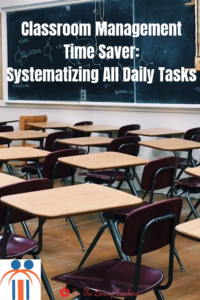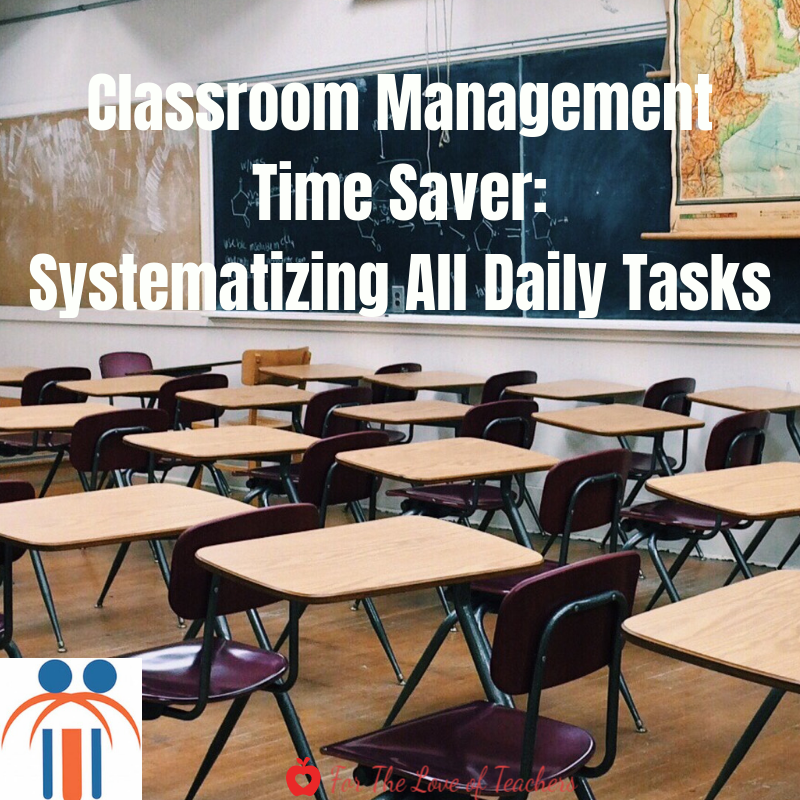At the beginning of the school year, it’s important to get your classroom management game on. I always feel like a “How To” tour guide. It is during the first weeks of school that I teach, model, and guide my students through every single routine and procedure from arrival to dismissal and all the important stuff in between, like how to use, distribute, and locate classroom materials and supplies, how to line up, how to sign out to use the restroom or nurse and how we transition from one activity or place to another. Responsive Classroom calls this Interactive Modeling. If you missed it, you can read all about this in my post, Interactive Modeling: Classroom Management Time Saver.
Thoughtful Teacher, a classroom management model designed to transform the way teachers manage their students, calls it “systematizing daily tasks.” Teachers who do not invest time in teaching, modeling, and systematizing all daily tasks will surely struggle with classroom management. When your students know exactly what, why, and how things are done in your classroom, understanding the method behind your organizational madness, it establishes a classroom learning environment that basically will run on its own with minimal interruptions in class.
So what tasks should you systematize? Here are a few important ones to get you started:
Arrival and Morning Routines
The way your students enter your classroom whether you are an elementary, middle, or high school teacher sets the tone for the day/period. In my classroom, it is the expectation that students greet their teacher, give smiles or quiet greetings to peers, go directly to their seats to unpack, and begin their morning work. Our day officially begins together during our morning meeting when we greet each other and get started. Classes that begin with chaos, rowdy, and unruly behavior often have a hard time settling down to get started. If you’re a middle or school teacher who only has 48 minutes in a period, every minute counts. Set the expectations from the start by welcoming your students into class and getting them started without any minutes lost. See my Interactive Modeling Morning Routine Script and Editable Morning Procedure schedule cards, both classroom management time-saving tools.
Lining Up, Walking, and Hallway/Stairwell Expectations
In elementary school, it’s important to teach, model, and practice lining up, walking, and stairwell expectations EVERY year. Do not assume that your students know how to do this the way you’d expect even if they are in 5th grade. Set the expectations and practice them over and over until they do it the way that is expected.
Example expectations for lining up:
-
Line up when your table is called
-
Walk to your designated spot in line (I assign line spots)
-
Stand tall and straight, eyes forward
-
Hands at side
-
Voices off
See my Modeling Script: Lining up and Walking.
The stairwell could be a pretty dangerous place with students’ shoes untied, and kids running up and down the stairs while skipping steps. I think I’ve seen it all. And when multiple classes are transitioning through periods, from specials, lunch, recess, and fire drills, this becomes a safety issue and concern. Be sure to model, teach, and practice appropriate and safe stairwell use. This one is sometimes overlooked. See my Modeling Script: Stairwell Expectations.
Paper Collection & Distribution
I see many teachers lose control of students during this very simple task. Why not have students do this one? In my elementary classroom, my students were more than excited to choose classroom jobs. They kept their jobs for 2 weeks before they had the opportunity to choose another one. I have a collector and a distributor and while they did their job, I was able to continue with my lesson or directions. No time was lost and no negative behaviors had the opportunity to develop. As a middle school or high school teacher, you may not assign “class jobs” but hand over a pile of papers to a student to give out or systematize a paper pass routine where one student takes a paper and passes it to the next person and so on. You don’t need to lose instructional time or manage behaviors just because of paper. Let your students take this one on.
Pencil Problems
There seem to be many pencil problems in classrooms today: the lack of pencils, misuse of pencils, students not having a pencil when they come to class, etc. Here are some suggestions that work:
-
If you have a supply list, collect pencils from all students at the beginning of the year. Sharpen and designate a place for students to take a pencil when they need it. I call this “Pencil Pickup.” Some teachers use a sign-out system for borrowing and returning pencils. Some middle or high teachers take the student’s cell phones as collateral in exchange for a pencil. When the student returns the pencil at the end of class, they get their cell phone back. Depending on how “severe” your pencil problem is you can decide on how you’d like to manage the borrowing and returning of pencils.
-
Have a place where students can return pencils. Dull pencils can be sharpened at the end of the day. Let a student do this. Sharpened pencils go to “pencil pickup” for the next day. I recommend that you don’t allow students to use the pencil sharpener during class. It’s a disruption and distraction because when one student sharpens a pencil, they ALL need to sharpen their pencil. If a student’s pencil point breaks, direct them back to “pencil pickup.”
-
What if you run out of pencils? Mid-year I send home a request for pencil donations. I take whatever I can get and of course, I buy and hoard my own stash of pencils to distribute when we are running low.
-
What if students are misusing and breaking pencils? I’d have a conference with that student and explain that a logical consequence would be that if they can’t use our class pencils as they are expected to be used, then that student loses the privilege of using our class stash of pencils. I model and teach how to use a pencil and other simple classroom materials and tools at the beginning of each school year. Misusing and breaking class materials is not acceptable. See my Modeling Script: Guided Discovery: Classroom Materials.
Restroom or Nurse Pass
If students need to use the restroom or go to the nurse, I teach my students hand signals that would reduce interruptions. When I see a hand signal I give a nod to acknowledge the student leaving the class to use the restroom and have a sign-out sheet by the classroom door. The student would quickly sign out with their name, date, time out, and time returned. This helped me keep track of how many times students left the classroom per period, per day, and for how long. Passes were hung by the classroom door too. If a student of mine had a pass, adults in the hallway knew where the child was going and where they were returning to. Check with your school nurse’s policy about sending students to the nurse. I had several nurse passes printed and ready to go but did have a brief conversation with the student before sending them unless it is an emergency.
Dismissal
Just like morning arrival, dismissal could be a chaotic time if not systematized. There have to be dismissal expectations and procedures in place. I expect students to have their homework assignments written and books out on their desks to show that they are ready to pack up. Students then have a free choice to either read, write, finish up classwork, do their class jobs, or tidy up their workspace while waiting for our class to be dismissed. Are your middle or high school students itching for the bell? Set the expectation that packing up is allowed only one or two minutes before the bell. See my Modeling Script: Dismissal Routine.
Papers, Papers, Everywhere
Put a system in place for checking and collecting assignments and homework. This tends to be a time-eater and a paper management nightmare. Here are a few ideas:
-
Think about what you are checking for, completion or accuracy. If you just want to see if students completed their work, could you just eyeball it and check off who didn’t complete it? That should take only a few minutes each day. If you are checking for accuracy and need to collect it, have students place their work in one designated place, like a tray or folder so you can have all papers in one organized place to grab and go when you are ready to check them.
-
What do you do with all these papers? Decide which assignments you’ll be returning. Don’t give assignments back with a star, check, or happy face just to show that you “looked” at it. Your students don’t want these papers back and they will most likely just go in the trash. I suggest filing papers such as these in student portfolios which serve as a collection of student work throughout the year. I share these portfolios at parent conferences to show the effort and quality of work the student produces. I have students help me file these assignments into individual student portfolios daily. Give assignments back to students that have meaningful feedback for students to reflect upon. Meaningful feedback is something your students will value and is worth both of your time. Pick and choose which assignments you’ll collect, return, and file.
Other tasks to systematize:
-
Taking attendance
-
Students who are late or leave early
-
Students who are absent
-
Transitions
-
Classroom organization and clean up
-
Small groups
-
Discipline (see my logical consequences script.)
There is just so much to teach, model, practice and systematize at the beginning of the school year before actual teaching and learning can begin. But I assure you that if you invest the time into doing so, it WILL pay off. Your classroom will run like a well-oiled machine and your students will be able to run it on their own. It’s a win-win!
If you think that Thoughtful Teacher is for you because you need or want support in classroom management then reach out to your admin about the benefits of Thoughtful Teacher. Don’t be afraid to ask for support or to educate them! For more information visit www.thoughtfulteacher.org. If you have any questions, you can contact info@thoughtfulteacher.org.
Follow me to be notified when new resources are uploaded to the Shop and join the email list to receive the latest and greatest updates, posts, and some awesome freebies!!
Missed it? Just Give Them A Darn Pencil and 5 Ways To Become a Classroom Management Rock Star.
If you like it, then pin it,



Christine Weis is a passionate educator, classroom management coach, wife, and mom of two busy boys. She enjoys teaching, writing, and creating resources for teachers.





Wow, I need to share this with my fellow friends who are teachers! I can see these tips being applied to every day routines as well. Thanks for sharing!
Great..thank you! Please do share! Thanks for reading!
Christine at For The Love of Teachers
Wow this awesome! I love how efficient and organized you are. You sound like an amazing teacher!
Thank you so much! I appreciate your kind words! Thanks for reading!
Christine at For The Love of Teachers
My girlfriend just graduated and started teaching at the beginning of this school year. I will send this blog post to her as I am sure she could use the helpful information!
Excellent…that’s fantastic! Please do share! Thanks for reading!
Christine at For The Love of Teachers
Not something I am used to reading but very informative. Will share this with my teacher buddies.
Great…thank you! Please do share! Thanks for reading!
Christine at For The Love of Teachers
I have so much respect for teachers. It is not an easy job!
Thank you so much…teachers truly appreciate that! Thanks for reading!
Christine at For The Love of Teachers
I just want to say that teachers have one one of the hardest and most important jobs in the world. Your love for teaching and for your students show in every one of your blog posts!
Thank you so much Nina! I appreciate that! I call myself a teacher geek but it is true passion and enthusiasm..all wrapped up into one teacher geek. LOL!!! Thanks for reading!
Christine at For The Love of Teachers
It’s so important to teach thoroughly all those transitions and to over teach them early in. I teach kindergarten and my kids walk in the halls with “belly hugs” and “bubbles in your mouth”. Quietest class in school!😇
I LOVE IT!!! Isn’t that the best when you have the quietest/the most respectful class in school?! It shows what a great teacher YOU really are too! Thanks for reading!
Christine at For The Love of Teachers
This is fantastic! I am going to share this with my teacher friends. 🙂
Thank you! Please do share…appreciate it! 🙂 Thanks for reading!
Christine at For The Love of Teachers
I know I couldn’t be a teacher because of all the chaos that can happen and you have to keep up with almost 30 lives. Teachers are superheros.
It’s a tough job but someone’s gotta do it. 😉 I have many capes! LOL!!! Thanks for reading!
Christine at For The Love of Teachers
I think this system helps keep the classroom organized. I think it is a great idea! I don’t go to school, but at my job there have been equipment going missing or people hoarding it, so I think that your system of checking in/out items can be used at the workplace as well.
Yes! Good point! All workplaces need to have daily systematized tasks. It makes the workplace run smoothly and efficiently so everyone could do their job! Thanks for reading!
Christine at For The Love of Teachers